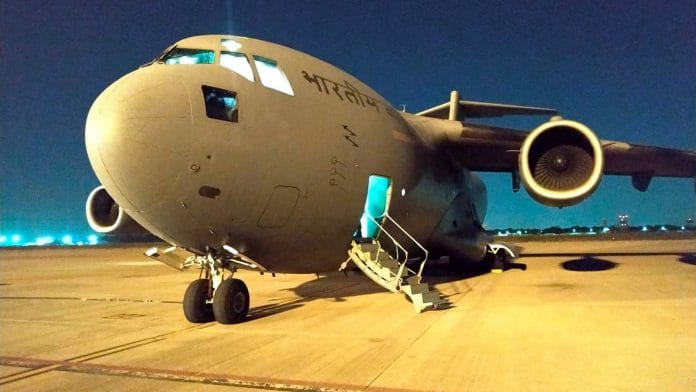The Akshay Kumar-starrer Airlift based on the 1990 Kuwait evacuation may be getting a plot for its sequel. India has planned the massive evacuation of almost two lakh Indians stuck in at least 12 countries due to the coronavirus pandemic.
This is one gigantic task that India is undertaking. The planning required is intricate and the execution has to be timely to meet the aspirations of the Indian community wanting to come home. To borrow a term used by aviators, it is catering to the GetHomeItis (get-home-itis) syndrome that normally afflicts flyers.
India has undertaken evacuations of such magnitude many times before, the one from Kuwait in 1990 being legendary in which 1,70,000 Indians were airlifted, predominantly by Air India and supported by the Indian Air Force (IAF). Then, from Libya in 2011 during the Libyan Civil War, where, under Op Safe Homecoming, around 15,000 nationals were given a sealift from Libya to Malta by the Indian Navy, and from there, by Air India back home. In 2015, under Op Rahat, Air India, the IAF and Indian Navy evacuated over 5,000 Indians during the Yemeni crisis. Some of the sorties flown by Air India pilots from Sanaa airport in Yemen were truly outstanding, in conditions that can only be described as hazardous – dust haze reduced visibility and absence of landing aids forced them to do visual approaches.
In the coronavirus evacuation, the Indian Navy, Air India and the IAF, if required, would be the flag bearers, once again.
I was the Assistant Chief of Air Staff at Air Hq looking after transport aircraft and helicopter operations, and can attest to the close inter-ministerial coordination required to plan such a massive operation, the intricate planning done in operational squadrons to sequence the flow of assets used in the evacuation and the dedication expected (and always exhibited) of the executors of the plan – pilots, sailors and technicians.
Earlier this year, the IAF has evacuated 170 Indians from China and Iran. But why is the IAF aircraft not being used this time and on stand-by? Four factors come in to play when Air Force assets are involved.
Also read: Vande Bharat vs Bharat ke bande: Can Narendra Modi be losing his political touch so soon?
Major clearances required for IAF
First, is the country from where the evacuation is to be done friendly to India? The Yemen mission required diplomatic skills of our foreign office to plan the flights, and only Air India, not the IAF, flew the Yemen-Djibouti leg after which the IAF took over. Remember, Gen. V.K. Singh, of the Ministry of External Affairs, was stationed in the area to lend weight to diplomatic interventions.
Second, the country from where the evacuation has to happen may be friendly, but are the countries over which the aircraft have to fly willing to play ball? I remember that during my tenure at Air Hq, a decade back, the biggest obstacle was getting overflight clearances from Pakistan for IAF aircraft launched to Afghanistan for evacuating Indian casualties of numerous blasts that hit our Embassy and Consulates. Third, if there are numerous countries that the aircraft have to overfly, then multiple clearances have to be obtained. These are valid for a particular time period, and with some countries being notorious for giving clearances only at the last moment, any delay by one means starting the whole process again. In one Central Asian country, the clearance was given personally by the President — and he could not be woken up before 10 am, bringing-in an additional obstacle for an urgent mission.
Fourth, are there diversionary airfields available in a friendly country if an IAF aircraft has to divert for any reason? A Mi-26 helicopter on a ferry flight to Russia had planned to avoid Pakistani airspace but had to divert to Karachi due a technical defect – the crew had a very ‘interesting’ tale to recount on the time spent there.
Also read: Three decades before Covid, India conducted the largest civilian evacuation in history
Civil aircraft better for carrying people
So, whether to use IAF aircraft or not in an evacuation of the type being undertaken now is a decision governed by many factors. On the other hand, civil aircraft have to only file a flight plan as per civil aviation rules – it’s a process that is streamlined, fast and relatively hassle-free. Additionally, they have the advantage of having onboard facilities made for passengers– proper seats, overhead storage, good lighting, galley for food and, most importantly, toilets – imagine 150 people on a 10-hour flight with just one rudimentary toilet onboard an IAF IL-76. Yes, C-17s are slightly better, but there are other tasks for them that the civil fleet cannot fulfil.
The transport fleet of the IAF, comprising C-17, IL-76, C-130 and An-32, has the primary role of warfighting, when ordered to do so. These assets are vital and have to be nurtured, especially in these Covid-19 times. It’s a no brainer that funds would be at a premium the next few years due to austerity measures, and hence, the flying hours and the residual ‘life’ available have to be used judiciously. The decision not to use IAF aircraft, at this stage of the Vande Bharat mission, is a sound one; but if required, the warriors in blue can easily carry out the mission.
The author is Addl. Director General, Centre for Air Power Studies, New Delhi. Views are personal







Well narrated Sir